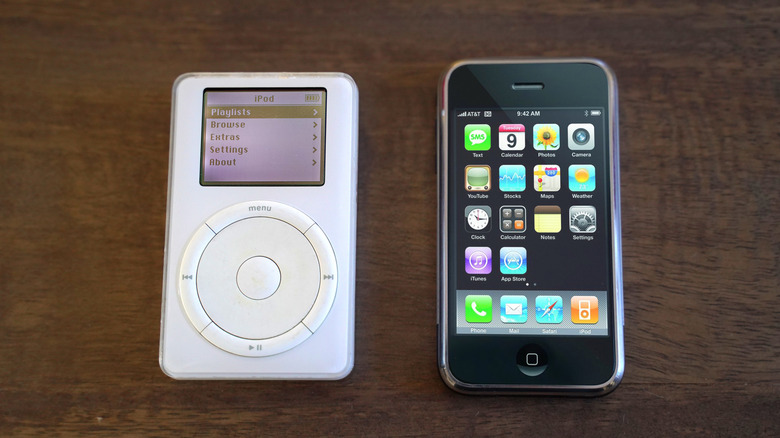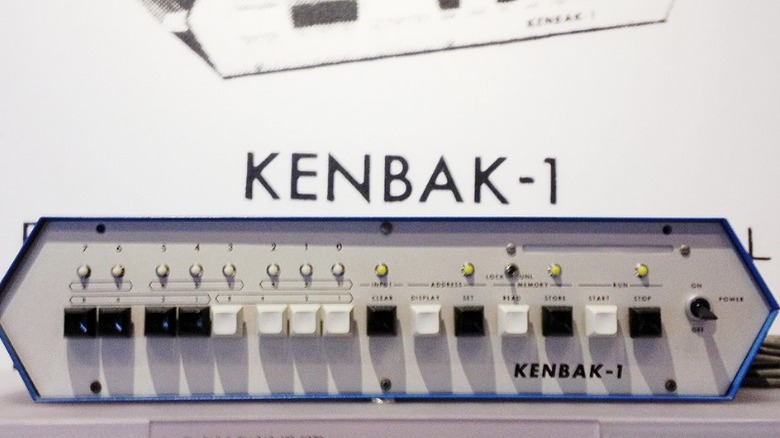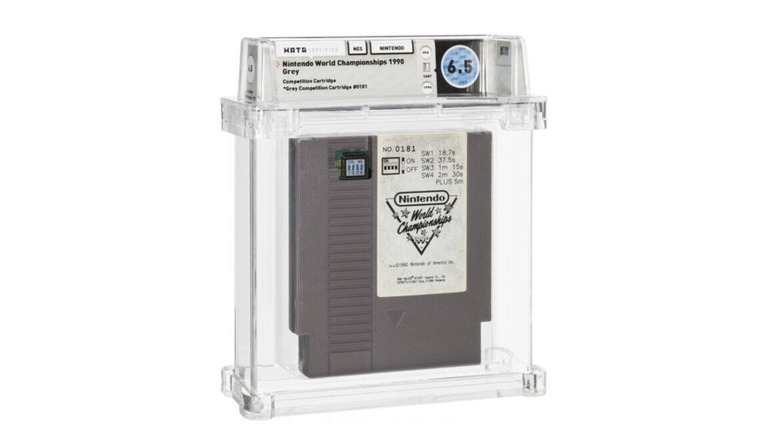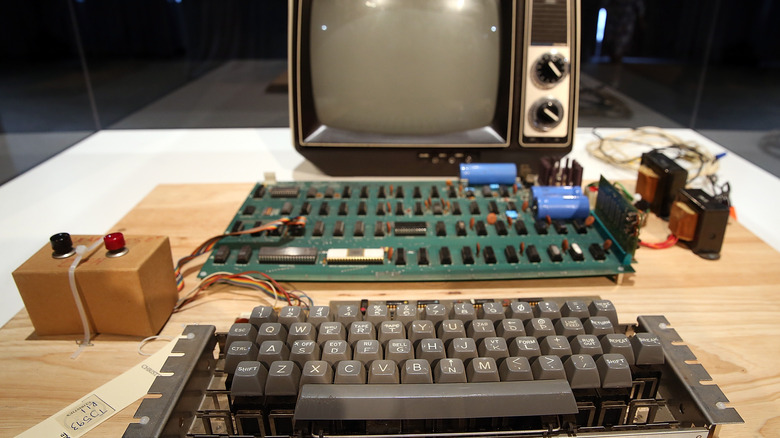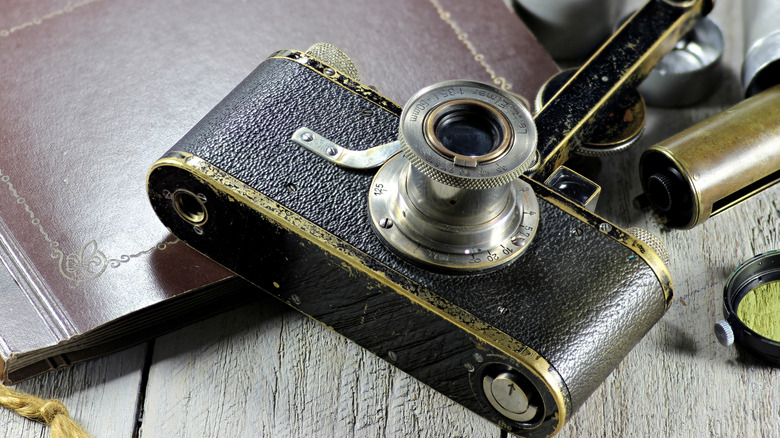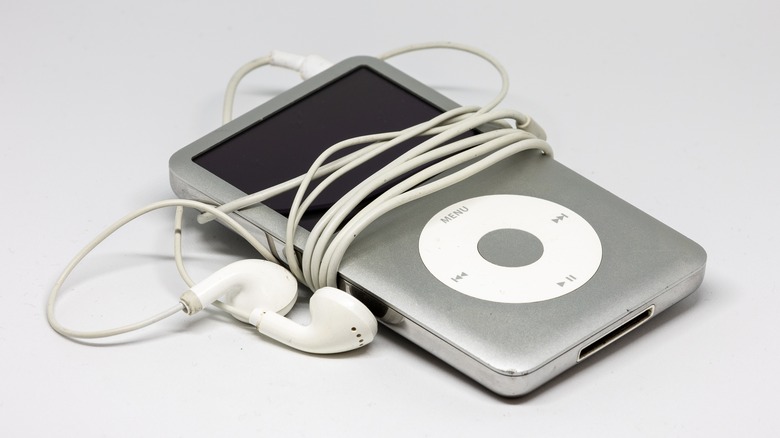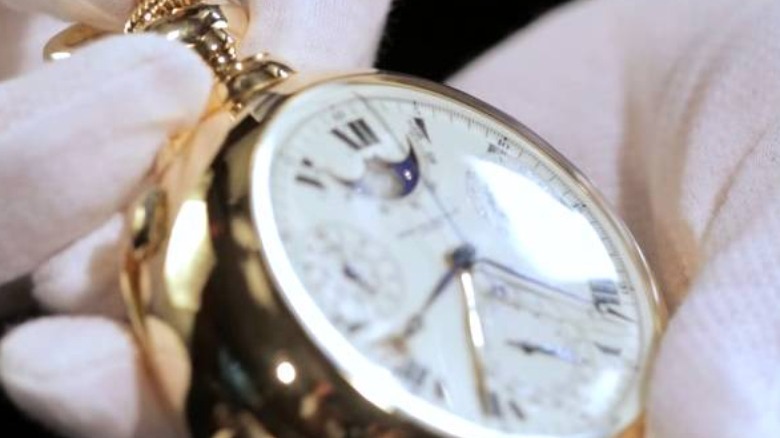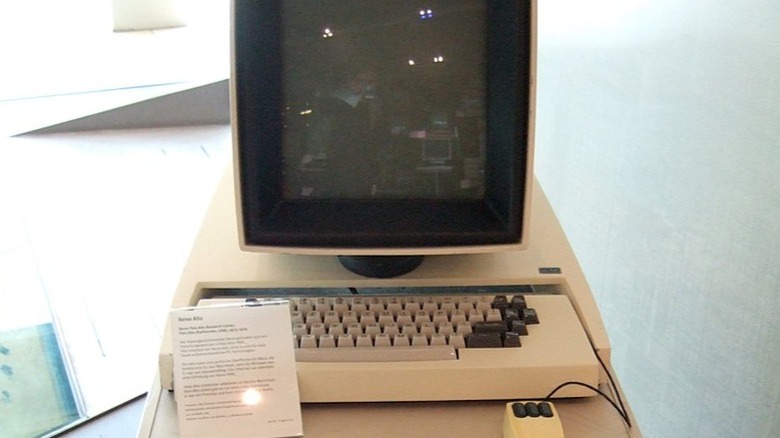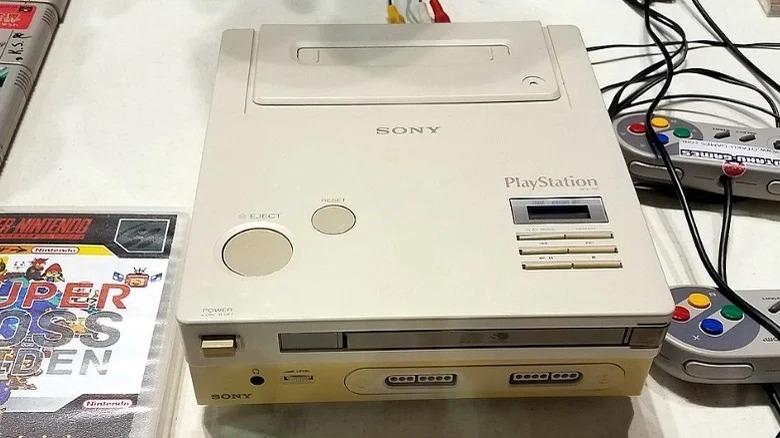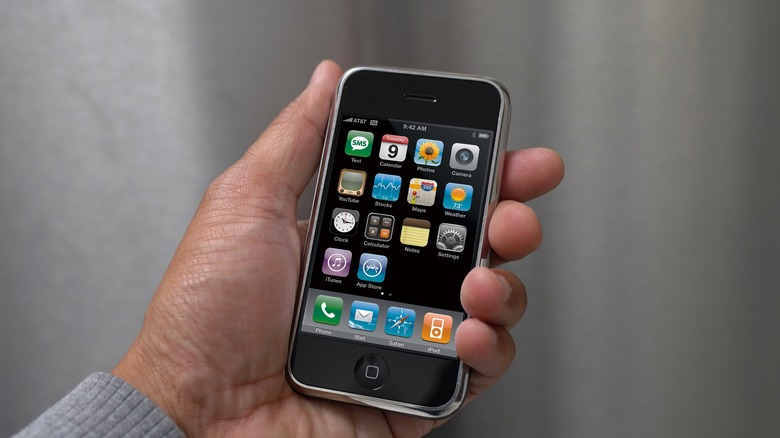10 Historic Pieces Of Tech That Sold For Unbelievable Prices
Over the previous century, technology has advanced at a rate unlike anything else in human history. People now walk around with powerful, but tiny computers in their pockets that are able to stream content, communicate with anybody around the world, and handle everyday tasks such as calling a cab or managing your finances. Meanwhile, practically every device in your home can now be "smart," from game consoles to household appliances.
Getting to this position hasn't been easy, though, and it has required both innovation and invention from some of the brightest minds. These historic pieces of technology might seem outdated today, but at the time they launched, they were top-of-the-line and helped pave the way for everything that came afterward.
The importance of these important items from history combined with their rarity means that they have become huge collector's items and can sell for massive amounts of money. In fact, you may not even believe how much these pieces of tech actually sold for.
Kenbak-1
Before the era of personal computers, the only users of computers were highly skilled technicians who were trained to use large mainframes. These machines often included multiple terminals so they could be used by several people simultaneously but required specific programming for each task and were nowhere near as useful or versatile as modern home computers. As technology advanced and components were able to be manufactured on a smaller scale, the idea of developing a computer that could fit inside a house became a more realistic possibility.
The Kenbak-1 stands out among the early PCs as it is widely considered to be the first personal computer in the world. It was designed and produced in 1970 before later going on sale. Costing $750 at the time of its release, only around 50 Kenbak-1 machines were built and of those only 14 are estimated to still be in existence. The computer had a unique design, necessitated by the fact that it was developed just before the invention of the microprocessor in 1971, which utilized small-scale integration TTL chips. With Kenbak failing to be commercially viable, the company was sold, and the name has largely disappeared from the world of technology.
Yet, the importance of the Kenbak-1 and its rarity has made working units highly desirable. Most of the computers in existence are on display in museums. One example was purchased by a European museum in 2015 at an auction in Germany for $45,000.
[Featured image by Kathryn Greenhill via Wikimedia Commons | Cropped and scaled | CC BY-SA 2.0]
Nintendo World Championship Cartridge
For almost the entire history of the video game industry, one name has been synonymous with the hobby. Nintendo helped propel gaming forward, releasing numerous hit franchises such as "Super Mario Bros." and "The Legend of Zelda," alongside a string of successful consoles and handheld devices — a tradition that continues to this day with the Nintendo Switch. With such a long and important role in the industry, it makes sense that many older Nintendo products are not just significant parts of gaming history, but also incredibly valuable. Perhaps the best example of this is the "Nintendo World Championship Cartridge."
These competition-specific cartridges were created for the Nintendo World Championship. This is an irregular tournament hosted in the U.S. that pits gamers against each other to determine the best player. First held in 1990, the initial iteration saw competitors play customized cartridges that contained modified versions of "Super Mario Bros.," "Rad Racer," and "Tetris" on similarly rare custom NES consoles in an attempt to get the most points in a set amount of time. The three games were chosen because of their popularity and the diverse gameplay challenges they offered as very distinctive experiences.
The fact that these cartridges were not intended to be released to the public and were largely kept by Nintendo to be recycled means that they are some of the rarest games ever made. Only around 100 are still believed to still exist and a handful of those have been publicly sold at auction. The highest verified price is $100,000, although several others have sold for similar prices.
Apple I
Nowadays, it is impossible to imagine a world without computers. They have become an essential part of our everyday lives, whether that means using a PC in the office to carry out work, or a laptop at home to browse the web. Yet, it wasn't all that long ago when the very idea of personal computers that could easily fit in a home or individual workstation was outlandish. Computers were not only much larger than their modern-day counterparts but also incredibly expensive, making them impractical in most situations. The Apple I changed all of that when it hit store shelves in 1976.
Designed and developed by Steve Wozniak, the Apple I was a technological marvel that allowed users to hook it up to a television monitor and keyboard to play games, access the ARPANET, and code with BASIC. The device demonstrated that there was a market for personal computers and also proved that it was commercially viable to produce them. Only around 200 were produced and sold, making it something of a rarity. A year later, Apple released a successor and offered heavy discounts to those who traded in the older model — mainly as a way of freeing up Wozniak and Jobs from providing customer service duties, while further limiting the number of working Apple I computers in circulation.
Combining the scarcity of the Apple I along with its importance in the history of personal computers, it should come as no surprise that they are highly sought after and valuable. A working version sold for a record $905,000 in 2014 while a subsequent auction in 2021 fetched a price of $400,000.
Hitler's phone
The Second World War was one of the most devastating conflicts in history. It has also played a hugely significant role in modern politics and culture, influencing events well into the 21st century. Considering all of that, it is not all that shocking to discover that relics, artifacts, and memorabilia from the time are highly sought after by collectors. Everything from tanks to uniforms are in demand, with collectors willing to spend huge amounts of money to get their hands on specific items. Some of the most valuable items come from figures who were important during World War II, such as Winston Churchill, Charles de Gaulle, Benito Mussolini, and Joseph Stalin.
However, it is memorabilia surrounding Nazi leader Adolf Hitler that usually captures the most attention. Whether it's due to some macabre fascination with him or simply a consequence of him being the most influential person in the war, personal items belonging to Hitler have always attracted attention. This has included everything from the dictator's Mercedes car to his writing desk and pistol.
The year 2017 saw a unique item go up for auction. Hitler's personal telephone, which was located at his bunker in Berlin, was out on sale and eventually purchased for $243,000. Exactly who bought it remains a mystery as the winning bid was made anonymously, but whoever it is got their hands on a red telephone inscribed with the Nazi leader's name. It was undoubtedly used by Hitler to relay orders to his officers.
Leica 0-Series
In modern times, it is easy to take photographs and cameras for granted. After all, we all have pretty advanced digital cameras in our pockets most of the time in the form of smartphones. Smartphones have given billions of people around the world the opportunity to capture images and video wherever they are. That wasn't always the case, however, and photography was once the domain of only the rich and powerful when cameras were huge mechanical devices that could not even be held in a person's hands.
The Leica 0-series became the most expensive camera ever sold when it managed to reach a price of $15 million in 2022. What makes this particular camera so desirable and important is the fact that it was an early prototype developed by Oskar Barnack in 1923, acting as a test to whether it was practical and useful to have a pocket camera that utilized 35-millimeter film. The success of the prototype eventually led to the first official Leica camera two years later and helped usher in an era of film photography that was previously impossible.
With an estimated 20 to 25 units of the Leica 0-series created, it is exceedingly rare. Research suggests that just over a dozen of them have survived, with fewer still in working condition. The record-breaking camera was previously owned by Barnacle himself and was in his family for decades, with other cameras selling for the smaller, but no less impressive prices, ranging from $1 million to $2 million.
iPod Classic
While the iPod is now discontinued, the device has had a huge influence on the modern world and the way that people consume music. Of course, it's true that the iPod was not the first MP3 player and other portable musical devices have been around for decades before it, but Apple's product range allowed people to easily carry around their entire music collections in their pocket and consume media in a brand new way like never before. The iPod became a cultural icon and is widely regarded as one of the most successful pieces of technology ever created, with an estimated 450 million units sold.
The iPod was first introduced to consumers in 2001 in the form of a device with a small screen and a click wheel for navigation. Over the course of the next two decades Apple released many variations, including the Shuffle, Mini, Touch, and Nano, yet none have been as iconic as the original Classic that established itself as the definitive MP3 player in a crowded market. The device did draw criticism, and was blamed by some for a rise in pirated music, yet it had an undeniable effect on the industry and helped revitalize Apple.
The original iPod Classic has become a collector's item. Models that are sealed and in working condition have sold for as much as $90,000, and even non-mint versions can still fetch tens of thousands of dollars at auction.
Patek Philippe Henry Graves Supercomplication
The Patek Philippe Henry Graves Supercomplication is a one-of-a-kind watch that was commissioned by Henry Graves Jr. as a way to try and impress fellow watch collector James Ward Packard. These figures were two of the most avid collectors of various timepieces in the world and often tried to outdo each other with ever more innovative and unique designs. This particular design was created by the Swiss clock manufacturer Patek Philippe in 1933, and is made of 18-karat gold.
As one of the most complicated pocket watches ever created, it had some 24 complications in total and cost 60,000 Swiss francs to create. These complications, which in horology means additional functions and features, included everything from a calendar to a celestial map from the point of view of Graves Jr.'s home. Built without the assistance of computers, the manufacturer took eight years to design and construct the Patek Philippe Henry Graves Supercomplication.
The watch stayed in the Graves family for many years before it was eventually sold at auction in 1969. In 1999, the watch again went up for sale and achieved a record-breaking price of $11 million. 15 years later, the watch was again sold, this time to an anonymous bidder. This time, the Patek Philippe Henry Graves Supercomplication again broke its own record as the most expensive timepiece ever, selling for $24 million.
Xerox Alto
The Xerox Alto was not the first personal computer and certainly not one that most people could afford. The machine was incredibly expensive, costing somewhere in the region of $12,000 to build in 1973, and would likely have gone on sale for more than $40,000 if it was available commercially. A few thousand were produced over the course of 1973 and the next few years, with most of the machines used by Xerox laboratories and research centers. Some were sold to universities in the U.S. at a price of $32,000.
What really made the Xerox Alto stand out was that it was the first computer to use a proper graphical user interface. This allowed users to navigate the various systems and software on the computer without relying on a text-based user interface or command lines. It was revolutionary at the time and set the path for how computers would be used with operating systems that included more sophisticated GUIs. Steve Jobs and other important figures from Apple took inspiration from the Xerox Alto when it came to producing the Apple Lisa, as well as the first Macintosh computers in the early 1980s.
Although the Xerox Alto cost a small fortune in the 1970s, it hasn't retained its value when taking into account inflation, as this would be well over $200,000 today. Yet, one did manage to sell for just over $30,000 in 2010 in an auction on eBay.
[Featured image by Joho345 via Wikimedia Commons | Cropped and scaled | Public Domain]
Nintendo PlayStation Console
Nowadays, Sony is one of the major players in the gaming industry. Its consoles have dominated the market for the last two decades, with the PlayStation name known throughout the world. The most recent iteration of the hardware, the PlayStation 5, has been an unprecedented success and shows no sign of slowing down. The PlayStation line first began in 1994 with the release of the first console, which sold more than 100 million units in total.
However, the history of PlayStation could have been very different. Sony first planned to enter the gaming industry by partnering with Nintendo to produce a CD-ROM accessory for the SNES, and later a console with a built-in CD drive. At the last minute, Nintendo backed out of the deal and instead decided to work with Phillips. The end result of this partnership was the much-maligned Phillips CD-i, but it also had the effect of pushing Sony to release its own console in retaliation. Thus, the PlayStation was born and Sony has never looked back.
While Nintendo and Sony never released the SNES/PlayStation hybrid, several prototypes of the proposed console were produced. Although there's little information about the number of units created, a working version surfaced in 2015. Due to the rarity and historical importance of the prototype console, the few units that are known to exist are quite valuable. When one was put up for auction in 2020, it fetched a price of $360,000 as a result of a bidding war between Oculus VR founder Palmer Luckey and Pets.com founder Greg McLemore, which McLemore ultimately won.
[Featured image by Paquitogio via Wikimedia Commons | Cropped and scaled | CC0 1.0]
iPhone (1st Generation)
It is hard to underestimate the influence of the iPhone. Following in the wake of the massively successful iPod, Apple launched its smartphone brand in 2007. Although it was not the first smartphone, and not the only device with a touchscreen, it did popularize the idea of removing most physical buttons in exchange for utilizing a larger screen that users could navigate directly using their fingers. Almost immediately, the iPhone became Apple's most popular product, and one that propelled the company to become among the most valuable in the world.
As of 2021, Apple has sold more than 2.6 billion iPhones and holds a global share representing around 15% of all smartphones worldwide. Laying the standard for what smartphones could be, the iPhone was more than just a phone. It could play music and video in high quality, connect to the internet, and do everything a normal cell phone could do. Throw in its camera and App Store that allows users to download millions of useful or entertaining applications, and the iPhone undeniably changed the way people thought about their phones.
With dozens of models released in the last 15 years or so, the iPhone is still seen as top-of-the-line, with Apple continuing to innovate and evolve the smartphone. While the newer models are expensive, none are quite as costly as sealed versions of the original iPhone. These can cost upwards of $15,000 to buy, with even later models able to command prices of several thousand dollars.
